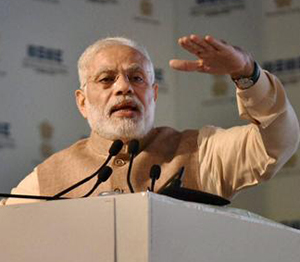Vadodara, Oct 22: Accusing previous governments of having "no vision" for aviation, Prime Minister Narendra Modi today said his government has come out with the first integrated policy for the sector and is working in a "mission mode" for its expansion which will spur growth and employment.
Dedicating the new integrated terminal building of the airport here, Modi noted that India in the near future would probably become the third country in the world in terms of airport activity benchmarks and "if you think only 80 to 100 airports are enough, then we are trying to create hurdles in the country's growth".
He said the country's development can take new dimensions if attention is given to tier-2 and tier-3 cities, which have the same potential, and referred to government's new regional connectivity scheme.
Attacking the previous governments, he said, "Earlier airports were set up, planes would fly but the country did not have an aviation policy.
"How to take the sector forward in next five or ten years and take care of its and passengers' needs, what should be done for common people, there was no vision in place earlier. It was just moving," he said.
"After the new NDA government came to power, for the first time since independence it formulated a new aviation policy for the country," he said inaugurating the terminal building which is now the country's second green airport after Kochi.
He said the new aviation policy will take care of the consumers' needs and the growth of the sector. Modi said that the aviation sector is growing at a very fast pace and more middle-class families aspire to travel by air.
"It is estimated that within five years, the situation in India would be such that the airports in the country would have as much footfall in a year as America's total population.
"You can well imagine how this sector is growing. India in the near future would probably become the third country in the world in terms of airport activity benchmarks. This will help increase employment opportunities and would spur economic activity," he said.
Spread in an area of 17,500 sq mt, the new integrated terminal has been built at a cost of Rs 160 crore. It has been designed to handle 700 passengers, including international fliers, per hour with 18 check-in counters, which would help in a seamless boarding process.
It took about seven years to complete the project as the then Civil Aviation Minister Praful Patel had laid the foundation stone in 2009.
The 8,100-meter-long runway of the Vadodra airport can handle small and narrow body aircraft such as Airbus 320 and Boeing 737s. Besides national carrier Air India, private airlines likes IndiGo and Jet aiways are operating from here.





Comments
knowing the expansion plan in advance Meredian college Mangalore started Aviation Management course for mangaloreans
Add new comment